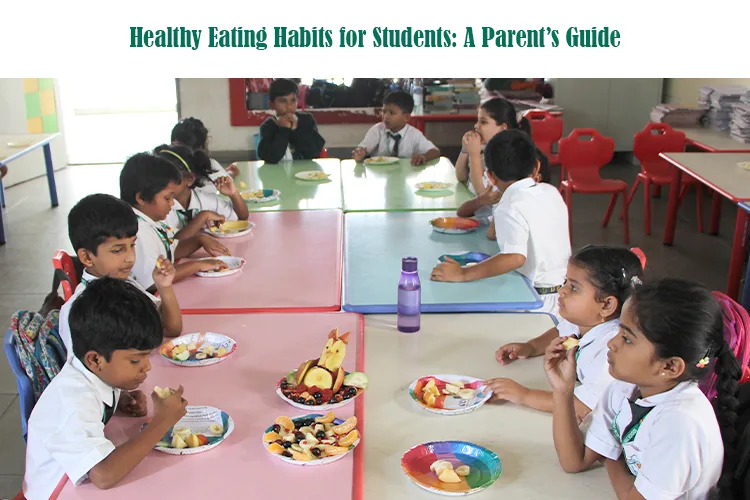Good dietary habits assist students in maintaining a normal weight, fortify their immune system, and help them concentrate better and remain energetic. In today’s society of packaged snacks, fast food, and sugary beverages, though, promoting good eating can be difficult. This guide will enable parents to see the need for good food and offer basic, hands-on suggestions for developing decent eating behaviors.
The significance of good eating for students
1. Increases brain capacity
Good nutrition betters learning ability, concentration, and memory. Students who eat a lot of whole grains, fruits, vegetables, and proteins score better in school.
2. Enhances body condition
Nutritious food intake boosts the immune system, lowers the likelihood of obesity, and helps to avoid life-threatening conditions, including diabetes and heart disease.
3. Lifts mood and energy levels
A good diet helps students remain active and joyful. Whereas balanced meals offer continuous energy, processed and sweetened foods might cause irritability and exhaustion.
4. Encourages development and expansion
Proper nutrition is needed by teenagers and children to help their bodies grow. Good muscle and bones, as well as general wellness, are constructed with nutrients such as protein, calcium, and vitamins.
Healthy dietary habits every student ought to adopt
1. Have a nutritious breakfast first thing in the day
The most important meal of all is breakfast. Students who get a healthy breakfast are able to stay attentive and concentrated.
A few nutritious morning selections are:
- Peanut butter on whole grain toast
- oatmeal containing nuts and fruits
- Eggs with whole wheat bread
- Smoothies containing seeds, fruit, yogurt
Tip for Parents: Parents should steer clear of processed items and sugary cereal. Inspire breakfasts are made from scratch with lots of protein and fiber.
2. Have fruits and vegetables in every meal
Alternate methods for increasing vegetables and fruits:
- Combine breakfast cereals or yogurt with sliced fruits.
- Serve hummus or cheese dip with vegetable sticks.
- Add a side of salad to your lunch and dinner pair.
- Create your fruit-based smoothie.
Tip for Parents: Essential fibers, vitamins, and minerals abound in produce. Inspire your kid to consume five servings of vegetables and fruits daily.
3. Opt for whole grains instead of refined ones
Long-lasting energy and satiety are offered by whole grains, including oats, whole wheat, brown rice, and quinoa. Refined grains such as white rice and white bread offer little nutritional value.
Improved Options:
- Replace white bread with whole wheat or multigrain bread.
- Pick brown rice rather than white rice.
- Opt for whole-grain pasta rather than normal pasta.
Tip for Parents: Whole grains provide sustained energy and fullness due to fiber and nutrients, unlike refined grains, which offer quick energy crashes and minimal nutritional benefit.
4. Add proteins-rich foods
Brain activity, energy, and muscle development all depend on protein.
A few of proteinaceous goods are:
- Chicken, sea food, and low-fat meats
- Beans, lentils, and chickpeas
- Seeds and nuts.
- Milk, cheese, and yogurt as well as dairy products.
Tip for Parents : If your kid is vegetarian, make certainly they consume enough plant-based protein found in nuts, lentils, and seitan
5. Drink lots of water
Good health depends on proper hydration. Many students run the risk of weight rise and lack of attention by drinking sweet sodas and juices instead of water.
Tip for Parents : For school, give your kid a reusable water bottle.Naturally flavoured water includes lemon, cucumber, or mint.
Scale back soda and sweet drinks.
6. Limit Junk Food and Sugary Snacks
Encourage healthy eating and limit unhealthy food. Sweet snacks , sweets, chips, fast food, and sodas are all high in bad salt, sugar, and fats. Regular eating can cause weight gain and health problems, though occasional snacks are okay.
Healthy options:
- Replace store-bought popcorn or baked sweet potato fries with homemade popcorn or baked sweet potatoes.
- Trade the sweets for fresh or dried fruits.
- Choose homemade sandwiches rather than quick food burgers.
7. Teach Mindful Eating Habits
Encourage children to eat slowly, chew properly, and listen to their hunger cues. Avoid distractions like TV or mobile phones during meals.
Mindful eating pointers:
- Consume together as a family.
- Offering correct serving amounts of food
- Don’t eat quickly
Healthy in between meal ideas for students
- Dried nuts and fruits
- Grated cucumber and carrot sticks.
- Homemade granola bars.
- Baked fish or tofu or steamed vegetables.
- Bread made from whole wheat
- Salad having olive oil dressing and beans
Ways parents could promote healthy eating
- Lead by example
Consume nutritious food and make good choices.By observing their parents, youngsters acquire knowledge
- Prepare more meals at home
Home-cooked dishes surpass restaurant or processed food in terms of nutritional value. Invite your child to help with meal planning to help it to be more appealing.
Create meals that are balanced.
Every meal should have some mix of vegetables, whole grains, good fats, and proteins.
- Food should not be a reward used
Choose non-food awards such additional playtime or engaging activity rather than giving treats as a reward.
- Teach Your Kid Nutrition Knowledge
Help your kid understand why some foods help them. Demonstrate to them how to interpret food instructions and pick wisely.
For a youngster’s physical and mental well-being, healthy eating habits are necessary. Parents may help their children to grow up strong, healthy, and attentive by making little dietary modifications. Small actions such as consuming more fruits and vegetables, staying properly hydrated, and steering clear of junk food might have a major impact on a kid’s life.
Help your youngster to establish lifelong healthy eating habits by first being a good role model and then making nutrition enjoyable. A happy, successful student is healthy!


